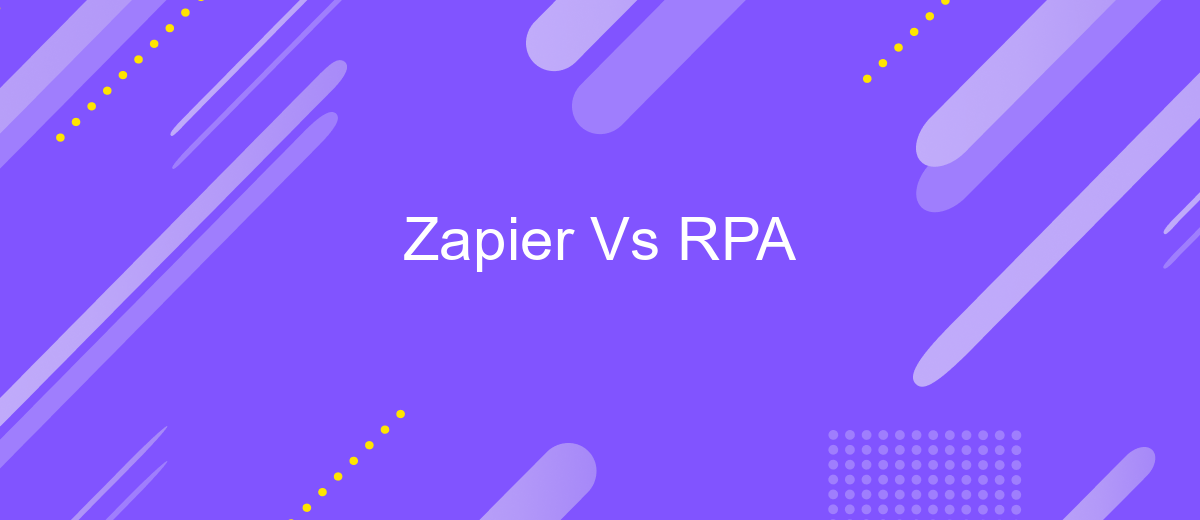Zapier Vs RPA
In today's fast-paced digital landscape, businesses are increasingly seeking automation solutions to streamline workflows and enhance productivity. Two popular options are Zapier and Robotic Process Automation (RPA). While both aim to automate tasks, they cater to different needs and use cases. This article delves into the key differences, advantages, and limitations of Zapier and RPA to help you make an informed choice.
Introduction
In today's fast-paced digital landscape, businesses are constantly seeking ways to streamline operations and enhance efficiency. Two prominent solutions that have emerged to address these needs are Zapier and Robotic Process Automation (RPA). While both aim to automate tasks and integrate various applications, they serve different purposes and offer unique features.
- Zapier: A user-friendly platform designed for non-technical users to create automated workflows between different apps and services.
- RPA: A more complex solution that mimics human actions to automate repetitive tasks, often requiring specialized knowledge for implementation.
- ApiX-Drive: A versatile service that simplifies the process of setting up integrations, making it easier for businesses to connect various applications without extensive technical expertise.
Understanding the differences between Zapier and RPA, as well as how tools like ApiX-Drive can complement these solutions, is crucial for businesses looking to optimize their workflows. This article delves into the strengths and limitations of each, helping you make an informed decision on which tool best suits your organizational needs.
Features and Capabilities

Zapier is a powerful automation tool that connects various apps and services, allowing users to create workflows known as "Zaps." These Zaps automate repetitive tasks without the need for coding knowledge. With a user-friendly interface, Zapier supports over 3,000 apps, making it versatile for numerous business needs. It excels in enabling seamless data transfer between applications, ensuring that information flows smoothly and efficiently across platforms.
On the other hand, Robotic Process Automation (RPA) offers more advanced automation capabilities, often used for complex business processes. RPA bots can mimic human actions to perform tasks such as data entry, invoice processing, and customer service interactions. Unlike Zapier, RPA can operate on a deeper level within enterprise systems, often requiring more technical expertise to set up and manage. For those looking to integrate multiple services effortlessly, ApiX-Drive provides an excellent solution, bridging the gap between different platforms and simplifying the integration process.
Pricing and Plans

When comparing Zapier and RPA, it's essential to consider their pricing and plans. Both platforms offer various tiers to accommodate different business needs and budgets. Zapier provides a free plan with limited features and several paid plans that scale up based on the number of tasks and integrations required. RPA solutions, on the other hand, often come with more complex pricing structures, typically involving licensing fees, setup costs, and maintenance charges.
- Zapier Free Plan: Limited to 100 tasks per month and basic integrations.
- Zapier Starter Plan: .99/month for 750 tasks and additional features.
- Zapier Professional Plan: /month for 2,000 tasks and advanced tools.
- RPA Solutions: Custom pricing based on enterprise needs, including setup and maintenance fees.
For businesses looking to streamline their integrations without breaking the bank, ApiX-Drive offers a competitive alternative. With straightforward pricing and user-friendly tools, ApiX-Drive enables seamless integration of various services, making it an attractive option for small to medium-sized enterprises seeking efficiency and cost-effectiveness.
Benefits and Drawbacks

When comparing Zapier and RPA, it's essential to consider the benefits and drawbacks of each. Zapier excels in its simplicity and user-friendly interface, making it accessible for non-technical users. It allows for quick and easy integration of various apps without the need for coding.
On the other hand, RPA (Robotic Process Automation) is more suitable for complex, large-scale automation tasks. It provides a higher degree of customization and can handle intricate workflows, but often requires more technical expertise to set up and maintain.
- Zapier Benefits: Easy to use, no coding required, wide range of app integrations, quick setup.
- Zapier Drawbacks: Limited to simpler tasks, may not handle complex workflows efficiently.
- RPA Benefits: Highly customizable, suitable for complex tasks, can integrate with legacy systems.
- RPA Drawbacks: Requires technical expertise, longer setup time, higher cost.
For those looking to bridge the gap between ease of use and powerful automation, services like ApiX-Drive can be invaluable. ApiX-Drive offers a platform to seamlessly integrate various applications, simplifying the automation process without sacrificing functionality.
Conclusion
In summary, both Zapier and RPA offer powerful tools for automating tasks, but they cater to different needs and use cases. Zapier excels in providing a user-friendly platform for integrating various web applications, making it ideal for small to medium-sized businesses looking to streamline their workflows without extensive technical knowledge. On the other hand, RPA is better suited for larger enterprises that require complex, rule-based automation of repetitive tasks across multiple systems.
For those seeking to simplify the process of setting up integrations, services like ApiX-Drive can be invaluable. ApiX-Drive offers an intuitive interface and robust features that allow users to connect different applications effortlessly, enhancing productivity and efficiency. Ultimately, the choice between Zapier and RPA will depend on the specific requirements of your organization, including the complexity of tasks, budget, and the level of technical expertise available.
FAQ
What is the main difference between Zapier and RPA?
Can Zapier be used for complex, multi-step automation processes?
Is coding knowledge required to use Zapier or RPA?
Can Zapier and RPA be used together?
What are some alternatives to Zapier for workflow automation?
Time is the most valuable resource for business today. Almost half of it is wasted on routine tasks. Your employees are constantly forced to perform monotonous tasks that are difficult to classify as important and specialized. You can leave everything as it is by hiring additional employees, or you can automate most of the business processes using the ApiX-Drive online connector to get rid of unnecessary time and money expenses once and for all. The choice is yours!

